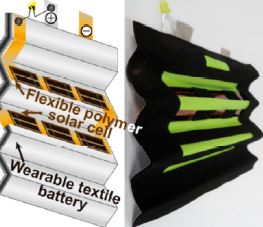A joint research by Professor Jang Wook Choi and Professor Jung-Yong Lee of KAIST Graduate School of Energy, Environment, Water and Sustainability (EEWS) and Professor Taek-Soo Kim from KAIST Department of Mechanical Engineering, developed wearable textile batteries that are able to be recharged by solar energy. Their research was published online in Nano Letters on October 18.

Fast-paced development in wearable electronics is leading to a paradigm shift in electronics. Such recent devices available to consumer products include Google Glasses, Samsung Galaxy Gear, and Apple’s i-Watch, and they are expected to pave new paths in the electronic market. To adapt to the recent developments, flexible and wearable electronic materials are of high value to scientific research as well.
The joint research was able to successfully realize this device by replacing key components of a rechargeable battery, which were conventionally rigid, with a flexible material. The critical electrode component was replaced with a mechanically robust electrode that are able to endure folding. A polyester textile coated with nickel metal and recoated with metal oxide electrode materials was used in this device. By using fabric material, the device was able to overcome limitations in mechanical stress, whereas conventional batteries using aluminum or copper plates break under excessive folding.
With the folding capability, the device was able to retain full operation even after 5,000 repetitive folding and unfolding. Also, the device was able to provide an electrical current of 85 milli-Ampere-hours (mAh) under 2 volts (V) electrical potential. A flexible and lightweight polymer solar cell was attached as well to the textile battery for it to become recharged when exposed to light. Researchers expect that in the future, batteries can be recharged under the sun through solar cells while users wear this device.
Professor Choi remarked, “We provided a breakthrough in one of the biggest challenges in battery technology for electronic products, and hope to use it as a key technology in the development of future rechargeable batteries.” He also stated, “By cooperating with rechargeable battery companies, a new era in information technology for mobile electronic devices will open.”
Shin Hum Cho
shinhum@gmail.com

